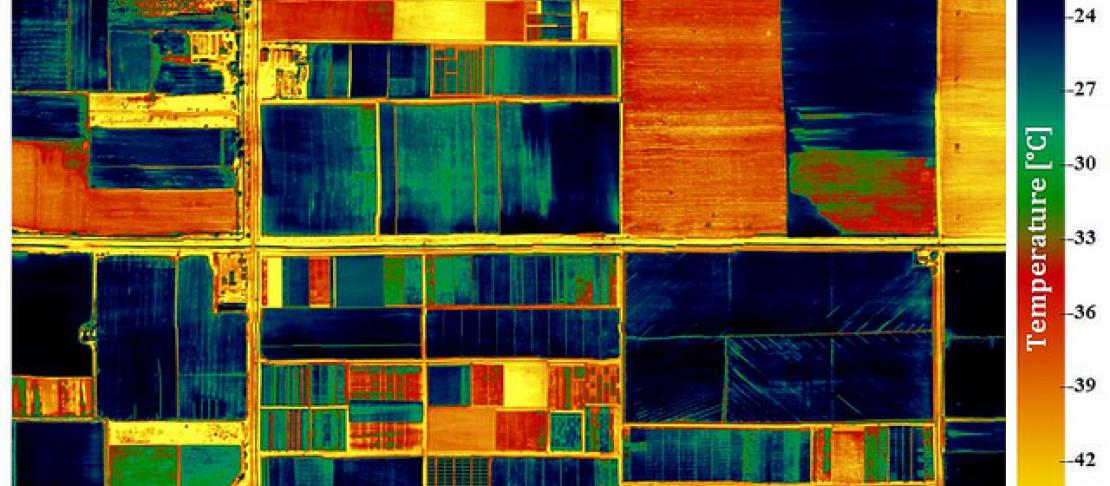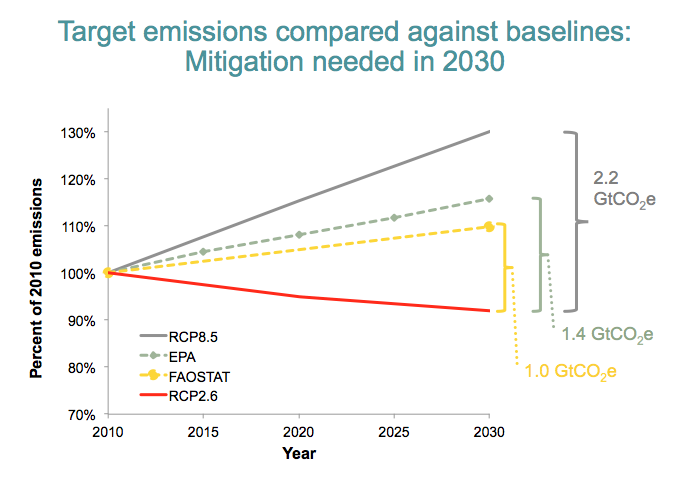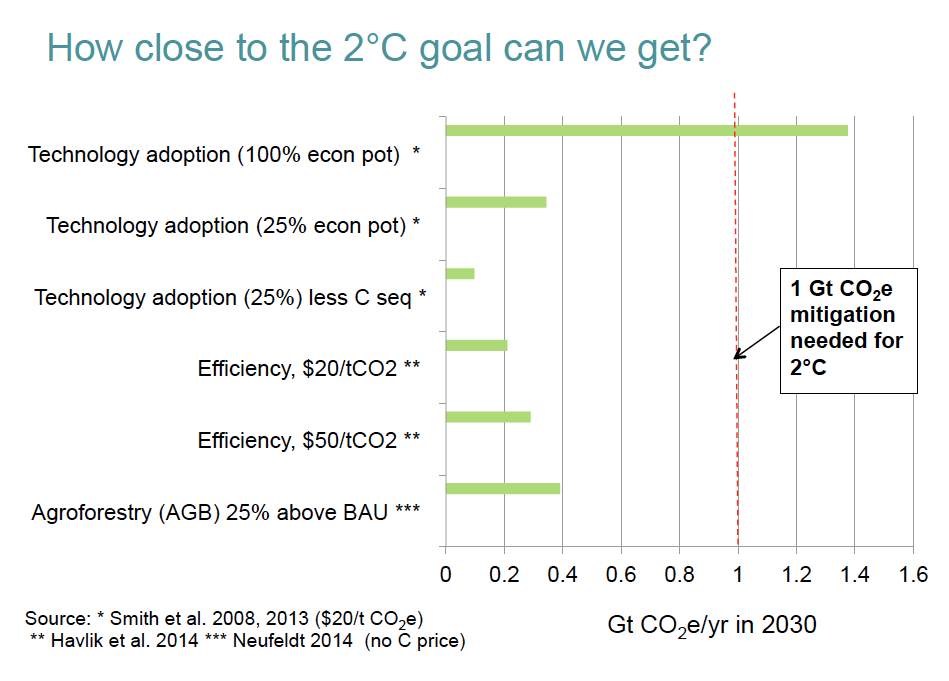Sustainable intensification will not keep us within the 2-degree goal for 2030

If agriculture is to share an economically efficient portion of the mitigation burden, investment is urgently needed to support massive innovation and changes in agricultural practices—and likely the entire food system.
There is a widely held assumption that sustainable intensification is a sufficient measure for reducing future greenhouse gas emissions in agriculture. We know that sustainable intensification at the very least decreases the emissions intensity of food. It also likely helps reduce emissions that would have occurred with less efficient systems in the future and “spares land” to avoid conversion of high carbon ecosystems such as forests in the humid tropics or peatlands.
So will sustainable intensification meet hard climate targets?
Not in the current trajectory, according to global models analyzed by Lini Wollenberg, leader of Low Emissions Agriculture for CCAFS, and colleagues. At the Climate Smart Agriculture Global Science Conference in Montpellier on March 17, Wollenberg summarized their findings:
Neither business-as-usual intensification of agriculture nor moderate adoption of mitigation practices will reduce emissions enough to avoid a 2-degree C temperature increase in 2100 compared to pre-industrial levels.
Sustainable intensification scenario
Wollenberg shared research results generated with IIASA, the University of Aberdeen, the Food and Agriculture Organization of the United Nations (FAO) and Wageningen University and Research Centre about whether the sustainable intensification needed to produce 60% more food for the expected population of 9-10 billion more people in 2050 is sufficient for meeting the hard climate goal of not surpassing a 2-degree Celsius rise in temperatures by the end of the century.
According to a widely used scenario of intensification expected in 2030 from FAO, agriculture will meet food production targets mostly through intensification (80% through yield increases and 10% through cropping intensity), rather than area expansion (10%). Estimates of emissions from FAO indicate about 5.8 gigatons of carbon dioxide equivalent per year of emissions in 2030 (represented by the yellow line in the graph below).
This “baseline” projection can be compared against the emissions predicted to occur in a desirable scenario that reflects keeping climate change within the 2-degree goal. To do this, the research team estimated the emissions associated with the agriculture sector in the representative concentration pathway (RCP) 2.6, a scenario prepared for the IPCC and expected to limit warming to less than 2 degrees C in 2100. Though it seems unlikely that the world could achieve the 2-degree goal at this point, it remains a relevant threshold for measuring dangerous climate change and an agreed-upon policy objective against which progress can be measured. (RCP 2.6 is represented on the red line in the graph below.)
Even with sustainable intensification of agriculture, Wollenberg and colleagues found that further reductions of emissions - of 1.0 gigaton of carbon-dioxide equivalent per year - are needed to meet the two-degree target in 2030.

we need to further decrease emissions by 1 gigaton of carbon-dioxide equivalent from the sustainable intensification scenario (yellow line) to meet the 2-degree warming Limit (red line).
How much can other low emissions practices help?
The research team then analyzed three different approaches to mitigation that are compatible with meeting the food production increases needed in 2030—technology adoption (Smith et al. 2008, 2014), moderate increases in production efficiency (Havlik et al. 2014), and agroforestry (Neufeldt 2014). Assuming realistic rates of change by 2030, the research team found that these approaches will not be sufficient to effectively curb climate change, even with carbon price increases to $50 per ton. Currently available, plausible agricultural interventions would achieve only 10-40% of the mitigation needed in agriculture by 2030.

Plausible agricultural interventions that meet Global food needs will only close the 1.0 gigaton gap by 20-40%.
What about slowing deforestation?
Much hope is often pinned on sustainable intensification as a means of avoiding land-use change driven by expanding agriculture, and many studies have examined the question of available cropland in the future. While in theory there is enough cropland globally to feed the globe’s expanding population, expansion of cropland in forest areas depends more on the geography of production, the drivers of production in a given locality and the governance of deforestation to prevent land use change. It depends less on global availability.
Wageningen research partners estimated that avoiding 25% of forest emissions caused by agriculture in 2030 would reduce emissions by about 1 gigaton. To achieve this mitigation, we would need to avoid conversion of about 1.2 million hectares of forest per year in threatened forest areas.
Reducing conversion of forests to agriculture will require strong, effective local governance and opportunities for local people to earn livelihoods outside of the forest. This is a work in progress, and current political will and institutions to implement this are insufficient, but there is reason for hope.
Opportunities
Wollenberg concluded her presentation with three options for achieving the mitigation needed to avoid drastic change in our ecological systems.
1. Build on current options for low emissions agriculture. Combine existing strategies to enable adoption of technical mitigation practices, facilitate more efficient structural changes in production and implement more effective governance of threatened forests.
2. Invest in radical, high impact innovations for the future such as biomass carbon capture and sequestration, reduced-methane ruminants and crops with biological nitrification inhibitors.
3. Explore feasible mitigation from dietary shifts and reducing waste. Research is underway to quantify how much dietary shifts away from animal protein consumption may decrease emissions while positively affecting food security and health goals. Further, reducing the estimated one-third of food wasted or lost as it moves from the farm gate to the consumer’s table each year could reduce demand for production.
Low emissions agriculture is necessary for a cost-effective way to meet climate change mitigation goals. And mitigation measures exist that are compatible with food production. The real question is how to massively scale up practices and innovate to decrease emissions while supporting human health.
View Wollenberg's presentation here.
Read more about the CCAFS presence at the Climate-Smart Agriculture conference here and the posters and presentations on Slideshare.
***
Following is a sampling of information available about low emissions agriculture practices:
- Alternate wetting and drying in rice
- Climate-smart livestock
- Conservation agriculture
- Precision nutrient management
References
Havlík P, Valin H, Herrero M, Obersteiner M, Schmid E, Rufino MC, Mosnier A, Thornton PK, Böttcher H, Conant RT, Frank S, Fritz S, Fuss S, Kraxner F, Notenbaert A. 2014. Climate change mitigation through livestock system transitions. Proceedings of the National Academy of Sciences.
Neufeldt H. 2014. Unpublished data. World Agroforestry Center (ICRAF).
Smith P., MartinoD, Cai Z, Gwary D, JanzenH, Kumar P, McCarl B, Ogle S, O’Mara F, Rice C, Scholes RJ, Sirotenko O, Howden M, McAllister T, Pan G, Romanenkov V, Schneider U, Towprayoon S, Wattenbach M, Smith JU. 2008. Greenhouse gas mitigation in agriculture. Philosophical Transactions of the Royal Society.
Smith P, Haberl H, Popp A, Erb K, Lauk C, Harper R, Tubiello FN, de Siqueira Pinto A, Jafari M, Sohi S, Masera O, Böttcher H, Berndes G, Bustamante M, Ahammad H, Clark H, Dong H, Elsiddig EA, Mbow C, Ravindranath NH, Rice CW, Robledo Abad C, Romanovskaya A,Sperling F, Herrero M, House JI, Rose S. 2013. How much land‐based greenhouse gas mitigation can be achieved without compromising food security and environmental goals? Global Change Biology.
Julianna White is Program Manager for the CCAFS Low Emissions Agriculture team.



